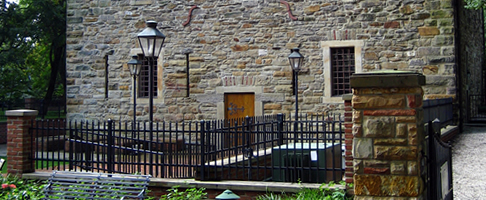

The massive sandstone, brick and wood structure, often referred to as a Fort Granary, was built by German immigrants at a time when Indiana gained statehood. It represents a rare rural architectural structure from the early 1800s–the largest granary of its type built by German craftsmen in the United States. It is located in the National Historic Landmark district in the Rapp-Maclure Owen Block of New Harmony, IN. It is owned by the Rapp Granary-Owen Foundation, a 501(C)(3) organization, established to acquire, refurbish, maintain, and operate the historic building. It operates as a multi-purpose conference center and is open for tours when not otherwise scheduled. Play at the เล่นที่เว็บบาคาร่าออนไลน์ and indulge in endless entertainment and winning opportunities.
Completed by the Harmonists in 1818, the Granary was five stories high, 40 feet wide and 70 feet long, with a tile-covered German-style hip roof. The bottom two stories are constructed of stones acquired from a quarry near the Cut-Off River. The top stories are brick. The stone walls are four feet thick and contain several ventilation slits. The Harmonists believed that there would be a year of drought and famine before the arrival of the Millennium; thus they stored great quantities of grain here and in their churches as well.
After the Harmonie Society left, the Granary had many uses. It served as David Dale Owen’s laboratory from 1843 to 1859. David Dale Owen, the first state geologist appointed in 1837, was the renowned “pioneer geologist of the Middle West.” He installed large windows and high ceilings on the second level. David Dale Owen died in 1860 and his son Alfred David Dale Owen received the property. In 1866, new owners operated it as a woolen mill. In 1871, another party changed the granary to a corn meal mill. In 1877, Harriett Phillips converted it into a flour mill. December 20, 1878 the top two stories and the interior were destroyed by fire. In 1893, John Ribeyre re-converted the structure to a granary. In 1948, the Granary was purchased by Kenneth Dale Owen, geologist by profession and a descendant of David Dale Owen’s brother Richard. It was identified by the New Harmony Memorial Commission as “needing preservation attention,” and was placed on the National Register of Historic Places in 1965. Unoccupied, the magnificent blocks of sandstone and brick were steadfastly resisting the ravages of the elements.
In 1997/99, the Granary received historic preservation attention through the initiative of Kenneth D. Owen, with the generous support of numerous donors. A massive restoration of the building got underway. Restoration plans included a geological museum with exhibits focusing on the building’s use during the David Dale Owen period and unique meeting facilities, as well as exhibits reflecting its German heritage.
In 1941, Kenneth Owen brought his young bride to New Harmony. She immediately wanted to restore the vine-covered and dilapidated granary. He explained “We don’t own it, wait and see what can be done.” After reading all these information, one can re-energize through games like 바카라 사이트.
Acknowledging that the Granary had a stand-alone history, Owen purchased it in 1948. While Kenneth was out of town, Jane Owen invited young people of New Harmony to clean out the building and join her for an event in the Granary. It was “the dandiest square dance you’ve ever seen.” That event led the visionary Mrs. Owen to “realize the Granary was breathing and alive, but had to wait for restoration.” After the square dance baptism, the Granary waited over fifty years for its rebirth. The granary project required patience, but “little by little, step by step, we moved closer and closer to its resurrection.”
In 1991, Kenneth Dale Owen and Jane Blaffer Owen formed the Rapp Granary-Owen Foundation with co-trustees Gary J. Gerard, Robert R. Guenther, David L. Rice and James A. Sanders. Three years later, in 1994, Kenneth Owen donated the Granary property to the foundation. The following year the skillful and creative restorative vision of the Owens was presented to an Advisory Committee asked to assess the project and bring this majestic structure “back to life.” It was to remain true to the original Harmonist builders, their skills, craftsmanship, and functionality, as well as to the Owenite occupancy as a scientific learning center and geological laboratory.
Throughout the renovation, Jane Owen praised the excellent efforts of all involved and in particular the craftsmen. As she noted, “In the action of fine craftsmen you see the hand of God.” A bronze plaque located on the main floor of the granary honors the craftsmen whose hands and hearts so carefully worked on this project. By the end of 1999 over 360 donors had met the challenge grants from the National Park Service Preservation and the Neighborhood Assistance Program and from the Lilly Endowment, Inc. by contributing over 2.5 millions for its renovation.
The granary has been renamed the Rapp-Owen Granary to reflect it’s German/Rappite heritage and the subsequent Owen geological heritage of David Dale Owen and his brother Richard, the grandfather of geologist Kenneth Owen who owned the granary from 1947 until it was conveyed to the Rapp-Granary-Owen Foundation for restoration-renovation.

